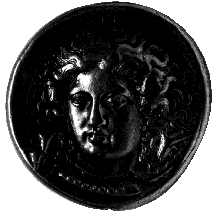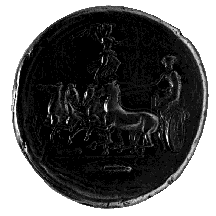



(17) Syracuse, Sicily (Italy) - AR tetradrachm, c. 410 B.C., 16.97
g. (inv. 93.007).
Obverse: Facing head of Arethusa, wearing earrings, necklace,
and headband, surrounded by dolphins; above, ![]() : Arethusa.
: Arethusa.
Reverse: Racing quadriga l. with Nike above; stalk of barley
in exergue; ![]() : of the Syracusans.
: of the Syracusans.
Provenance: Ex Benson collection; Harlan Berk, 1991.
Bibliography: L.O.Th. Tudeer, Die Tetradrachmenprägung
von Syrakus in der Periode der
signierenden Künstler (Berlin 1913); C.M. Kraay, Archaic and
Classical Greek Coins (Berkeley and Los Angeles 1976) 222-223.
This coin, attributed to the artist Kimon, was one of the most influential
coins of the ancient world because of its new facing composition on the
obverse; similar facing female heads can be seen on coins from all over
the Mediterranean (see nos. 25, 28,
29, 34, 36,
38). The head depicts the Syracusan nymph Arethusa.
Great detail is given to the eyes, which are large and clearly defined.
Her hair, in earlier coins pulled back, flows freely around her. The dolphins
pass through her hair, as though swimming in waves. The headband in many
examples bears the name of the artist.
On the reverse, the typical sedately moving Syracusan quadriga has been
transformed and now gallops in the midst of its race. The item just below
the hooves of the horses probably represents a racing post that has been
knocked down during the race. The charioteer turns his head back for a glance
at the competition. These elements add a realistic touch to the traditional
depiction. In the exergue, the ear of barley refers to the agricultural
prosperity of the island. The prevailing view of the chronology of late
fifth century Syracusan coins puts the coins with this feature in the last
decade of the century.
K.S.



All contents copyright (c) 1996.
Lawrence University
All rights reserved.